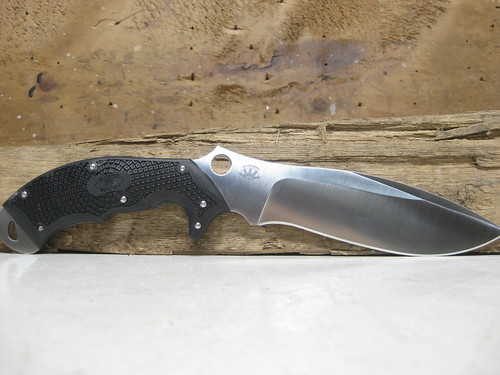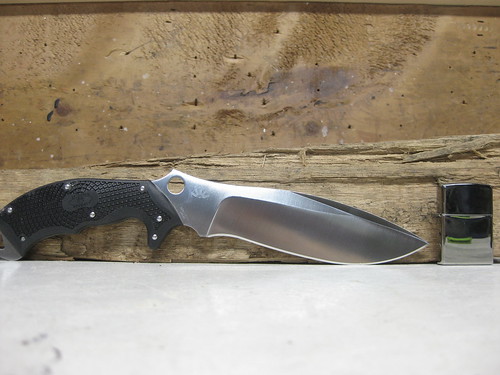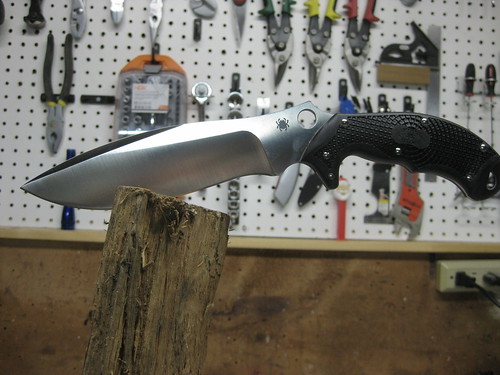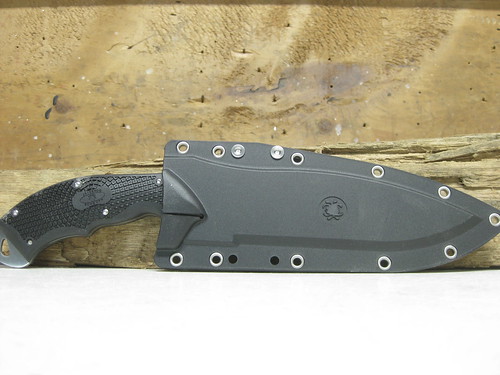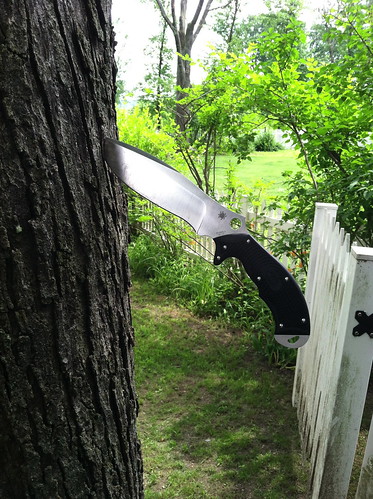Spyderco Rock Review
As someone that writes a blog on EDC gear, fixed blade knives rarely occupy my focus, but every once in a while I hanker for a big ole slab of steel. Fortunately, the kind folks at Blade HQ were good enough to accommodate me and send me a Spyderco Rock, designed by Ed Schempp. You and I both get that fixed blade itch and a week or two later, once the slab o' steel arrives, we are outside swingin' and choppin' with gusto. I will come clean and tell you that I do, in part, imagine myself as Indiana Jones making his way through the Amazon jungle to the mouth of a cave--you know, the one with the boulder in it.
The Rock is designed by Ed Schempp, an in-house Spyderco designer. Schempp's style is one of curve and exotic flair. He is the man behind many of the Spyderco Ethnic series knives. His Persian and Mini Persian are favorites among the Spyderco cognoscenti. He likes post-pivot choils and negative handle angles (the handle's spine is below the spine of the blade). All of these things come together brilliantly in the Rock. It is part American chopper, part khukri. It has the negative handle angle and the late choil of his folders. And, like all Schempp designs, it is truly wonderful in the hand.
Here is the Rock's product page. There are two versions: the Rock Salt H1 version and the cheaper VG-10, which is the model I reviewed. The VG-10 version is cheaper running around $150, while the H1 sold for more when it was in production. Here is a written review of the Rock, albeit the Salt addition. Here is a video review. Here is a link to Blade HQ, where you can find the Spyderco Rock, and all proceeds benefit the site when you purchase things through this link:
Blade HQ
Finally, here is my review sample:
Design: 2
The Schempp style is really an ergo-first sensibility that is disguised as lots of curves. Looking at Schempp's essential touches and those of Ken Onion you might not be able to tell the difference between the two, but years of using designs by both have shown me that while Onion is happy when aesthetics and ergonomics coincide, such as in the wonderfully sleek Swindle, Schempp is all ergos, all the time. He just happens to be SO good at designing knives and tools that they look as good as they function. The Rock is this in spades.
Here is the Rock next to a Zippo:
Its a big knife.
Clearly an attempt by Spyderco to make a chopping knife with a twist, its big blade (6.75 inches) and aggressive approach to material, thanks to the khukri shape, make it a formidable chopper. Machetes and choppers occupy a spectrum, with long, thin, forward-leaning machetes on one end and thick, balanced choppers on the other end. The Rock is dead center on that spectrum, with a blade steel that is 3/16" thick. It is not as thick as the premiere ax replacement blades from Cold Steel, the Trail Master and Recon Scout, both of which come in at 5/16", but it is not as thin as the vast majority of machete tools available, all of which hover around 1/8" thick. This compromise thickness has its advantages--the Rock is much easier on the arm and shoulder--and its disadvantages--the lack of thick blade stock lessens the wedge physics a chopper uses to split and baton wood. Overall, I think I like the compromise, but you need to be aware up front: this is not a knife that can't easily pop apart wood in batonning. Compared to my 1/4" thick RD-7, the Rock is a slow and painful batonning knife. It can do it, but it is not at its best during this task. But if you just need something to fell saplings and clear brush, more machete work, the Rock is perfect in this role. It is more confidence inspiring than a spring steel machete and lighter and more maneuverable than a pure chopper.
Fit and Finish: 2
The sheath, the handle, and clip are all quite nice, but the blade itself is a splendor to behold. All of the grind lines are crisp and the satin finish is among the nicest I have ever seen.
This is a pricey fixed blade, but a lot of that cost went into making a very good looking and very nicely finished tool.
Handle Design: 2
Schempp's design chops and ergos first approach is seen best in his handles. Even when limited by the form, such as in a folding knife of a particular style (like his Persian), he makes knives that sing in the hand in multiple positions. The Rock is no different, except here he is free to do virtually anything he wants. The result is a fixed blade that feels better in the hand than just about anything else I have used. The handle is good in a full swing grip, when you use the forward choil, or in a reverse grip. It is thin for a fixed blade handle and that thinness makes for a great knife in your hand. It is convex and checkered with the normal Spyderco pattern and all of this is almost seamlessly mated to the full tang steel underneath the scales. Truly great, probably the best part of this very good knife.
Steel: 2
I am not a huge fan of VG-10 in folders, but in choppers it seems like a very good steel. The 5160 I have in the RD-7 is good but it has a tendency to roll and chip (odd combination, I know). It is hardened to 54-56 HRc. The VG-10 on the Rock hits a bit higher, as Spyderco's VG-10 is typically between 57-59 HRc. But VG-10 is still a relatively soft steel. In the high shock application of a chopper it is really quite good. After batonning oak it still had a good utility edge, not hair shaving, but very good. After two, it was done. In between though, I did tons of cutting, using the Rock around the house for yard work (oh fuck yeah, I was THAT guy). Despite the loss of an edge, there were no chips or rolls to speak of really. It is superb as a fixed blade steel, better than the RD-7's 5160 by a wide margin.
The VG-10 version is probably the one I would opt for if both were available (the H1 Rock is out of production). I say this for two reasons. First, I have no need for the more expensive rust free steel. VG-10 is plenty corrosion resistant for my needs. Second, H1, while impervious to the elements, holds an edge roughly as well as chalkboard chalk. For that reason as well, I'd opt for the VG-10 version. It is nice to know that the H1 version is out there if you are seafaring bloke and need it.
Blade Shape: 1
Okay, okay the blade shape is fine, great actually, when cutting. It is sharpening that is a challenge. I absolutely HATE recurves, but as a chopper the recurve is really great. It brings the blade to the material at an aggressive and constantly changing angle. But trying to get this big blade over the stones on the Sharpmaker with the recurve, well, let's just say it was not fun. There are ways to put an aggressive angle on the blade without using a recurve, a negative angle on the handle, for example. The recurve is nice, just not worth the improvement in cutting performance when compared to the hassle of sharpening.
Grind: 2
As with the rest of the knife, the grind was immaculate. The grind lines were clean and wobble free. The cutting bevel was wide, but not too wide. The main grind is a very good hollow grind and the top swedge is a big weight saver. The only knock here, and it is a small one, is that the swedge, while not sharp, is pointed making batonning a bit of a challenge. The hammer wood is often pulpy by the time you make it through the main piece. Overall, very good.
Sheath Carry: 1
I love the sheath's shape and size. It is very well made.
But the attachment point is TOO low. The handle of the Rock was well past my elbow when the sheath was attached to my belt. I am sure I could fidget with it, but this is a real issue. Running or fast, flexible movement is all but impossible. This is not a knife you can carry on your hip on a long hike and given what fixed blades are often used for, this is an issue. A custom sheath is an option, of course, but for this price, you'd rightfully expect a little better.
Sheath Accessibility: 2
This is not like a custom sheath, the ones that have death grip on a blade. There is a little rattle, but not much. The knife is REALLY in there with nothing but the worse snag capable of taking it out on accident. Running through bush did not dislodge the knife. However, a quick, confident tug by your hand pops the knife out with a single clean jerk. Probably as good as you can get in a production sheath--a great balance between retention and removal.
Usability: 2
I did some serious chopping with the Rock, limbs of trees, batonning, brush clearing and the like. The knife worked better than my RD-7 in part because it was lighter and better balanced and in part because the handle is so expertly crafted. No hotspots developed even under very heavy use (removing a ten foot tall rhododendron bush from my backyard).
At some point I probably should have used a saw, but no matter what I did the Rock worked very well. Any heavy blade will give rise to shoulder fatigue after a while and the Rock is no different. The mark of a fixed blade with high usability is that it takes longer than normal to get there. With that as the benchmark, the Rock performed excellently.
Durability: 2
There was nothing that caused me to panic when using the Rock. Even the most forceful strikes during batonning proved no match. The handle scales never budged either in my hand or on the knife. The sheath laughed off blows and scraps. And the 3/16" thick VG-10 handled everything very, very well. I was concerned that such a thin blade stock, relatively speaking, wouldn't hold up, but it was fine. You can get by with 3/16" in a chopper provided you are aware that it will make batonning more work. Its not an issue of ruggedness though. Without the more steeply angled wedge driving the wood apart I had to pound longer and harder (insert joke here) than I would with the thicker stock of the RD-7. But never did I feel like I would break the blade. The Rock is just that--a rock of ruggedness, thanks in large part to the wise use of VG-10 and the excellent blade shape (for chopping at least).
Overall Score: 18 out of 20
This is a better knife than the RD-7. The steel is nicer, especially because coated fixed blades ALWAYS look like garbage after use. The blade shape is very good. The stock is a little thin, making some ultra-heavy duty tasks more difficult, but for the most part, it worked very well. The handle shape, classic Schempp in style, is a wonder to behold. I think a very focused chopper design might incorporate a lot of the good features of the Rock, retaining the excellent balance and control, and adding that final element that makes something the perfect chopper--unadulterated mass. Between the RD-7 and the Rock, there is no question which is better. The sheath is a meh largely because of where the clip is positioned, but that is a small knock. I am looking for a chopper from the Falkniven, the Busse stable, and the new Cold Steel Warcraft fixed blade line (Cold Steel fixed blade beefiness, CPM 3V steel, and sculpted G-10 handles, no kraton crap...sounds good, but they only have a Tanto available right now) to find out what the absolute high end of a the production chopper world looks like, but until then, and for under $150 the Rock is an excellent choice. The Rock is also an excellent choice if you want a big fixed blade but can’t justify buying a pure chopper. It is maneuverable enough to work as something less than a chopper, but it can be pressed into that role with only minor issues.
The Rock is designed by Ed Schempp, an in-house Spyderco designer. Schempp's style is one of curve and exotic flair. He is the man behind many of the Spyderco Ethnic series knives. His Persian and Mini Persian are favorites among the Spyderco cognoscenti. He likes post-pivot choils and negative handle angles (the handle's spine is below the spine of the blade). All of these things come together brilliantly in the Rock. It is part American chopper, part khukri. It has the negative handle angle and the late choil of his folders. And, like all Schempp designs, it is truly wonderful in the hand.
Here is the Rock's product page. There are two versions: the Rock Salt H1 version and the cheaper VG-10, which is the model I reviewed. The VG-10 version is cheaper running around $150, while the H1 sold for more when it was in production. Here is a written review of the Rock, albeit the Salt addition. Here is a video review. Here is a link to Blade HQ, where you can find the Spyderco Rock, and all proceeds benefit the site when you purchase things through this link:
Blade HQ
Finally, here is my review sample:
Design: 2
The Schempp style is really an ergo-first sensibility that is disguised as lots of curves. Looking at Schempp's essential touches and those of Ken Onion you might not be able to tell the difference between the two, but years of using designs by both have shown me that while Onion is happy when aesthetics and ergonomics coincide, such as in the wonderfully sleek Swindle, Schempp is all ergos, all the time. He just happens to be SO good at designing knives and tools that they look as good as they function. The Rock is this in spades.
Here is the Rock next to a Zippo:
Its a big knife.
Clearly an attempt by Spyderco to make a chopping knife with a twist, its big blade (6.75 inches) and aggressive approach to material, thanks to the khukri shape, make it a formidable chopper. Machetes and choppers occupy a spectrum, with long, thin, forward-leaning machetes on one end and thick, balanced choppers on the other end. The Rock is dead center on that spectrum, with a blade steel that is 3/16" thick. It is not as thick as the premiere ax replacement blades from Cold Steel, the Trail Master and Recon Scout, both of which come in at 5/16", but it is not as thin as the vast majority of machete tools available, all of which hover around 1/8" thick. This compromise thickness has its advantages--the Rock is much easier on the arm and shoulder--and its disadvantages--the lack of thick blade stock lessens the wedge physics a chopper uses to split and baton wood. Overall, I think I like the compromise, but you need to be aware up front: this is not a knife that can't easily pop apart wood in batonning. Compared to my 1/4" thick RD-7, the Rock is a slow and painful batonning knife. It can do it, but it is not at its best during this task. But if you just need something to fell saplings and clear brush, more machete work, the Rock is perfect in this role. It is more confidence inspiring than a spring steel machete and lighter and more maneuverable than a pure chopper.
Fit and Finish: 2
The sheath, the handle, and clip are all quite nice, but the blade itself is a splendor to behold. All of the grind lines are crisp and the satin finish is among the nicest I have ever seen.
This is a pricey fixed blade, but a lot of that cost went into making a very good looking and very nicely finished tool.
Handle Design: 2
Schempp's design chops and ergos first approach is seen best in his handles. Even when limited by the form, such as in a folding knife of a particular style (like his Persian), he makes knives that sing in the hand in multiple positions. The Rock is no different, except here he is free to do virtually anything he wants. The result is a fixed blade that feels better in the hand than just about anything else I have used. The handle is good in a full swing grip, when you use the forward choil, or in a reverse grip. It is thin for a fixed blade handle and that thinness makes for a great knife in your hand. It is convex and checkered with the normal Spyderco pattern and all of this is almost seamlessly mated to the full tang steel underneath the scales. Truly great, probably the best part of this very good knife.
Steel: 2
I am not a huge fan of VG-10 in folders, but in choppers it seems like a very good steel. The 5160 I have in the RD-7 is good but it has a tendency to roll and chip (odd combination, I know). It is hardened to 54-56 HRc. The VG-10 on the Rock hits a bit higher, as Spyderco's VG-10 is typically between 57-59 HRc. But VG-10 is still a relatively soft steel. In the high shock application of a chopper it is really quite good. After batonning oak it still had a good utility edge, not hair shaving, but very good. After two, it was done. In between though, I did tons of cutting, using the Rock around the house for yard work (oh fuck yeah, I was THAT guy). Despite the loss of an edge, there were no chips or rolls to speak of really. It is superb as a fixed blade steel, better than the RD-7's 5160 by a wide margin.
The VG-10 version is probably the one I would opt for if both were available (the H1 Rock is out of production). I say this for two reasons. First, I have no need for the more expensive rust free steel. VG-10 is plenty corrosion resistant for my needs. Second, H1, while impervious to the elements, holds an edge roughly as well as chalkboard chalk. For that reason as well, I'd opt for the VG-10 version. It is nice to know that the H1 version is out there if you are seafaring bloke and need it.
Blade Shape: 1
Okay, okay the blade shape is fine, great actually, when cutting. It is sharpening that is a challenge. I absolutely HATE recurves, but as a chopper the recurve is really great. It brings the blade to the material at an aggressive and constantly changing angle. But trying to get this big blade over the stones on the Sharpmaker with the recurve, well, let's just say it was not fun. There are ways to put an aggressive angle on the blade without using a recurve, a negative angle on the handle, for example. The recurve is nice, just not worth the improvement in cutting performance when compared to the hassle of sharpening.
Grind: 2
As with the rest of the knife, the grind was immaculate. The grind lines were clean and wobble free. The cutting bevel was wide, but not too wide. The main grind is a very good hollow grind and the top swedge is a big weight saver. The only knock here, and it is a small one, is that the swedge, while not sharp, is pointed making batonning a bit of a challenge. The hammer wood is often pulpy by the time you make it through the main piece. Overall, very good.
Sheath Carry: 1
I love the sheath's shape and size. It is very well made.
But the attachment point is TOO low. The handle of the Rock was well past my elbow when the sheath was attached to my belt. I am sure I could fidget with it, but this is a real issue. Running or fast, flexible movement is all but impossible. This is not a knife you can carry on your hip on a long hike and given what fixed blades are often used for, this is an issue. A custom sheath is an option, of course, but for this price, you'd rightfully expect a little better.
Sheath Accessibility: 2
This is not like a custom sheath, the ones that have death grip on a blade. There is a little rattle, but not much. The knife is REALLY in there with nothing but the worse snag capable of taking it out on accident. Running through bush did not dislodge the knife. However, a quick, confident tug by your hand pops the knife out with a single clean jerk. Probably as good as you can get in a production sheath--a great balance between retention and removal.
Usability: 2
I did some serious chopping with the Rock, limbs of trees, batonning, brush clearing and the like. The knife worked better than my RD-7 in part because it was lighter and better balanced and in part because the handle is so expertly crafted. No hotspots developed even under very heavy use (removing a ten foot tall rhododendron bush from my backyard).
At some point I probably should have used a saw, but no matter what I did the Rock worked very well. Any heavy blade will give rise to shoulder fatigue after a while and the Rock is no different. The mark of a fixed blade with high usability is that it takes longer than normal to get there. With that as the benchmark, the Rock performed excellently.
Durability: 2
There was nothing that caused me to panic when using the Rock. Even the most forceful strikes during batonning proved no match. The handle scales never budged either in my hand or on the knife. The sheath laughed off blows and scraps. And the 3/16" thick VG-10 handled everything very, very well. I was concerned that such a thin blade stock, relatively speaking, wouldn't hold up, but it was fine. You can get by with 3/16" in a chopper provided you are aware that it will make batonning more work. Its not an issue of ruggedness though. Without the more steeply angled wedge driving the wood apart I had to pound longer and harder (insert joke here) than I would with the thicker stock of the RD-7. But never did I feel like I would break the blade. The Rock is just that--a rock of ruggedness, thanks in large part to the wise use of VG-10 and the excellent blade shape (for chopping at least).
Overall Score: 18 out of 20
This is a better knife than the RD-7. The steel is nicer, especially because coated fixed blades ALWAYS look like garbage after use. The blade shape is very good. The stock is a little thin, making some ultra-heavy duty tasks more difficult, but for the most part, it worked very well. The handle shape, classic Schempp in style, is a wonder to behold. I think a very focused chopper design might incorporate a lot of the good features of the Rock, retaining the excellent balance and control, and adding that final element that makes something the perfect chopper--unadulterated mass. Between the RD-7 and the Rock, there is no question which is better. The sheath is a meh largely because of where the clip is positioned, but that is a small knock. I am looking for a chopper from the Falkniven, the Busse stable, and the new Cold Steel Warcraft fixed blade line (Cold Steel fixed blade beefiness, CPM 3V steel, and sculpted G-10 handles, no kraton crap...sounds good, but they only have a Tanto available right now) to find out what the absolute high end of a the production chopper world looks like, but until then, and for under $150 the Rock is an excellent choice. The Rock is also an excellent choice if you want a big fixed blade but can’t justify buying a pure chopper. It is maneuverable enough to work as something less than a chopper, but it can be pressed into that role with only minor issues.

